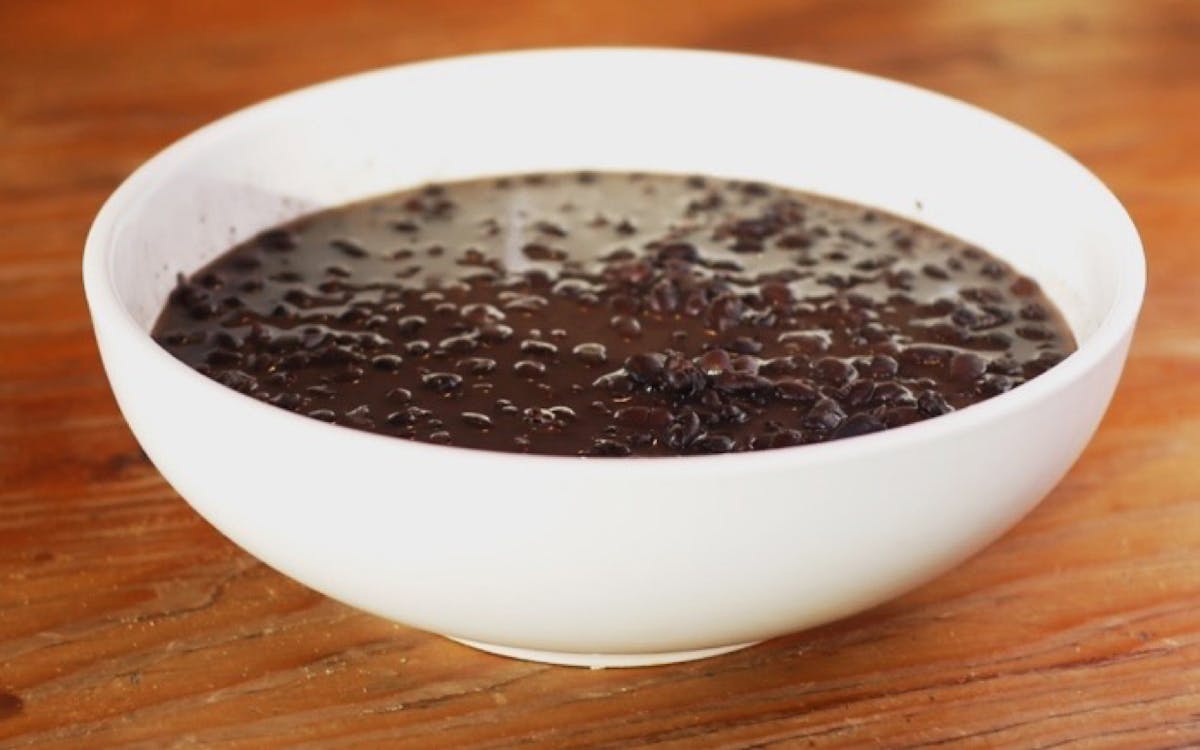The Iconic Black Bean

Cuban Black Bean Soup
Black Beans are a cherished component of a Cuban meal and at the heart of Cuban cuisine. To say they are a staple of how we eat is an understatement. Simply put, Cubans love their black beans. Some worship them and have strict personal guidelines as to how they should be served: some prefer them a bit watery and some prefer them thick or more viscous, what some called “dormido” or sleepy beans. When prepared this way, the beans pour slowly from the bowl onto the rice, such as how someone awaking from a good night’s sleep slowly gets out of bed. Some Cubans add raw chopped onions or a splash of olive oil on top of their beloved beans – all perfectly legitimate preferences (I’ll get to the unacceptable ones in a moment).
When paired with plain white rice, black beans are quintessential comfort food. There are thousands of recipes available. However, most of them include food items that are just not traditional and not used in most authentic Cuban restaurants and households. In their simplest form, black beans are seasoned with: 1) sofrito; 2) traditional dried spices; and 3) pork fat (however, a good quality extra virgin olive oil added at the end is a perfectly good alternative). To this preparation, some add vinegar and some add some sugar. On a recent trip to Havana, I found the beans to be sometimes a bit sweet, which I personally don’t care for, and I don’t think is representative of how most Cubans eat their beans, so I will leave it out of this recipe.
If you want to create truly traditional Cuban beans, leave out the smoked products, like bacon or ham hocks. Many recipes call for this, but it´s just not needed. Less is more in this case. I’ve seen tomatoes in some recipes: this is not traditional and changes the character of the beans. I´ve also seen the addition of chicken or vegetable stock. No. And no to paprika as well. And please, please – I know it’s hard for many of you – no cilantro, no crema or sour cream, no chilies, jalapeños, chipotle, or hot chilies of any sort should come near these beans if you want them to be Cuban.
Tasting Notes: It’s important to clarify that the term “soup” here is misleading. Cubans don’t generally eat this dish as a soup, but rather as an essential accompaniment to most meals, either poured over rice or just eaten as a side to the entrée. Most importantly, the beans should be rich, one-note, & deep (which is why cilantro or cream alters this tremendously). Also, you should not really taste any of the seasonings. If you taste the garlic, cumin or oregano, too much as been added. But it should be just enough that you know it’s in there. When I’ve encountered beans that are too spicy, too much cumin is often the culprit. Take it easy on the cumin. Remember, black beans are meant to be a section of the orchestra, not a solo player. They’re meant to compliment the rice, root vegetables, and proteins that are typically already well-seasoned. Also, you should not see any of the components of the sofrito in the final product. They should have melted away in the cooking process. My personal pet peeve is when I see pieces of onions or peppers swimming in my beans.
For the real Cuban experience, include fried plantains, either crispy “tostones” that are made from un-ripened green plantains or with “maduros,” which are sweet and caramelized from the starches that have converted into sugar from the ripening process (“maduros” literally means ripe). Rice and beans can be super healthy and a satisfying breakfast when you pair it with eggs.
This recipe is for a larger quantity than usual, 10 – 15 servings. This was done intentionally, as black beans freeze perfectly and are nice to have around.
- Black Beans ~ 2 Lbs. (sorted through for stones and any other debris)
Sofrito
- Spanish or White Onion ~ 1 Medium
- Green Bell Pepper ~1 Medium
- Garlic Cloves ~ 6-8 Large Garlic cloves
*The ration of onions to bell peppers should be around 60% to 40%.
- ½ lbs. Salt Pork ~ (You can skip this and just add more olive oil at the end for vegan beans) (most grocery stores carry this. A typical brand is Hormel)
- Bay Leaves ~ 2 medium or 1 large
- Cumin ~ 1 Teaspoon
- Dry Oregano ~ 3 teaspoons (do not use fresh)
- White Vinegar ~ 2 Teaspoons
- Kosher Salt ~ 1 – 1.3 oz. or 5 – 7 teaspoons of kosher salt (if using regular salt use 2 – 4 teaspoons). Add little by little desired salinity
- Extra-Virgin Olive Oil ~ ¼ cup or ½ cup (for Vegan recipe)
- Water ~ About five to six quarts, depending on whether you cook it with a top or no.
1 – Place beans in a pot with 4 quarts of water. Peal onion and cut into quarters. Clean the seeds and stem from pepper and quarter. Add the onions, peppers, and whole garlic to the beans and water and let sit overnight.
2 – Rendering fat: Cube salt pork and cook over low-medium heat with about 2 tablespoons of cooking oil for about 15 – 20 minutes until all the fat is rendered. Keep the fact and throw out the salt pork.
3 – Finely dice onion and green pepper and cook in rendered pork fat or in ¼ cup of olive oil (for vegan option. Save the ¼ cup to add at the end) for about 15 minutes. Add chopped garlic at the and cook for a few minutes avoiding any browning of the garlic.
5 – Add the rest of the ingredients and cook for a total cook time of 2 – 2 ½ hours. Beans should break down and naturally thicken the soup
6 – Turn off heat and let sit for 20 minutes
7 – Puree one cup of the beans in a food processor and put back into the soup. Add more water if necessary (see cooking notes below)
8 – Add the olive oil and it’s ready to serve
Cooking Note – Cuban Black beans should have a pretty thick consistency from the long cooking time. This process breaks down the beans and the proteins that are released. Therefore, a critical element to the cooking process is Time. The beans at one hour are going to look very different then at 2 ½ or 3 hours. A common mistake is to not cook them long enough. They should not be watery, but rather have the consistency of a bisque or baked beans.
